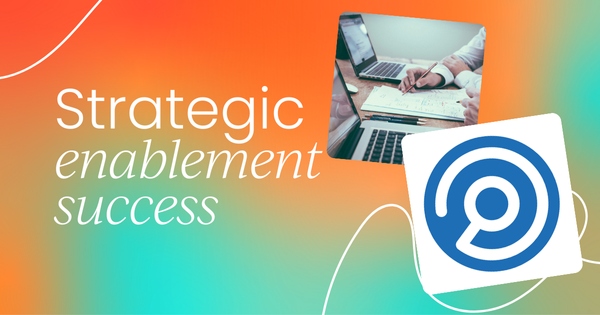Almost every customer we speak to is trying to change or evolve in some way. They are dealing with disruptive and aggressive competitors, demanding customers, and constantly changing business conditions.
In nearly every market, companies are constantly tuning how they go to market.
They may be launching new products, entering new markets, moving to selling value rather than features, or all of the above. They are trying to improve the productivity of their sellers, ramp their new hires faster, and drive a higher ROI from their marketing efforts.
To support those changes, customers tell us about all the investments they are making. They are doing more... of everything.
Pushing more things at their sellers, starting more initiatives, creating more content, building more training—but it isn't enough. The business strategy isn't turning into consistent execution on the ground, and too many great ideas "don't land" in the field.
To understand why, let's start by focusing on the sellers.
They are in the middle of all this, and they are the critical connection point to your customers. The company's challenges in the market hit their wallets every month. And for many of them, the global pandemic has turned how they sell on its head.
In fact, Gartner reports that 44% of B2B buyers now prefer not to speak to a sales rep at all.
Sellers experience an endless set of well-intentioned efforts to help that, unfortunately, often make things worse. New material comes at them left and right. When one new topic is launched, they learn just enough about it to get confused before being hit with the next one.
For many sellers, the best strategy is to tune out the noise and focus on what is both familiar and comfortable. When that happens, change dies.
As they struggle to achieve their targets, many sellers give up and leave. A few who are particularly talented or lucky will excel. The end result is a team performing far below its potential.
Product marketing and enablement work overtime, often with frustratingly little to show for all their efforts. Getting sellers to change is notoriously difficult. But that is the fundamental job of enablement - to drive change at scale.
Doing that effectively in the service of the key priorities of the business is what we call strategic enablement. Many of us in B2B sales enablement have had to figure out what to do as we go along, because there hasn't been a standard framework we can rally behind to consistently make positive change happen. Companies have long used sales methodologies to align on what good selling looks like and used storytelling frameworks to craft their messaging.
What has been missing is an enablement methodology to implement those ideas consistently and effectively.
We've been fortunate to partner with hundreds of companies and thousands of practitioners, from some of the world's most sophisticated sales, enablement, and marketing organizations. We've worked with them to turn strategy into consistent execution and dramatically grow their businesses.
We'll show you what the most successful companies are doing and how you can apply it to your own business.
Strategic enablement framework: turn your strategy into consistent execution
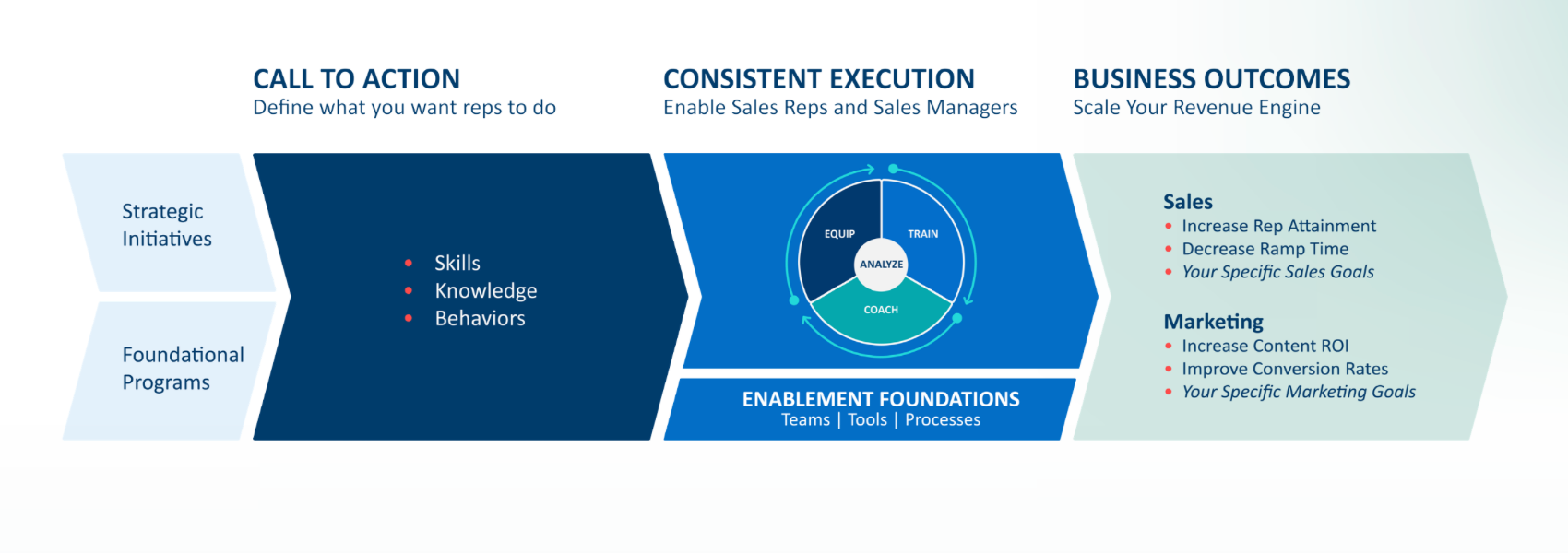
The starting point of the framework is deciding what you are trying to achieve.
You might want to drive a specific strategic initiative, such as launching a new product, deploying a new sales methodology, or moving to value selling.
Or you might want to build selling capability through a foundational program, such as improving how you onboard new sellers. In either case, the goal is to change rep behavior.
Call to action:
To drive change into your sales organization, it is critical to start by clearly defining what you want your sellers to do. The more detailed and specific you are about this, the better. You typically want to help them master key selling skills, learn knowledge essential for working effectively with customers, and engage effectively in leveraged behaviors that move the sales process forward.
Consistent execution:
With a clear idea of what you want to accomplish, you can turn that into action. There are three key steps:
- First, systematically equip your sellers with the resources they need. This might involve customer-facing collateral (such as a pitch deck, brochures, and case studies), internal collateral (a demo script and tips on objection handling), and one or more sales plays (what you want your sellers to know, say, show, and do). Success here means that sellers can say, "I get it. I know what you want me to do, and I have the tools I need to do it."
- Then you train them through a set of learning experiences, often combining self-service and instructor-led courses, with opportunities to demonstrate their expertise. Success means they can confidently say: "I am confident that I know how to execute."
- Finally, you coach them on the new activities in the real world. This is usually done by their managers, who may need support to know how to do it well. The goal is that sellers can say, "I have the support I need to be successful at this new activity with customers."
- Supporting all three of these steps, you need to analyze exactly what is and isn't-happening on the ground, with visualizations that help distill that data into insights you can act on.
Business outcomes:
The reason you are driving change is to achieve certain outcomes. To get there, you need to get clear on what you want, what success looks like, and how you will measure it. The more closely your metrics align to the actions you are driving in the field, the better you are able to measure the effectiveness of your enablement process.
Enablement platform:
You have to have the right enablement team, tools, and processes in place to implement the Equip, Train, Coach model. If elements of that platform are shaky or missing, you will struggle to drive change and execute effectively on your business priorities.
Let's dig into each part of the framework in more depth.
Call to action
If you want to successfully drive change into the field, you first need to get very clear on what specific actions you want your sellers to do. It seems pretty obvious, but we've seen many, many companies get tangled up on this first step, or just ignore it altogether.
When it comes to defining the call to action, there are two mistakes we see companies make over and over again:
They aren't specific enough
It's very common, for example, to launch a new product by providing a collection of assets that describe it, such as pitch decks and case studies. Then you hold a training session to teach sellers about the product... and that's it. The call to action is "go sell the new product".
But that leaves all the hard work to the sellers. Which customers should they engage with? How? When? With what specific messaging? What happens next?
If you haven't done the work to define exactly what you want people to do, you are almost guaranteed to get wildly inconsistent activity across the organization-and wildly inconsistent results.
They have far too many
One of the biggest and most consistent complaints from sellers is that they are constantly getting hit with new things they are supposed to be doing, and they never have enough time to master any of them.
According to a 2021 survey, 70 percent of respondents reported that their company's sales process has become more challenging in the past 12 to 18 months.
It is really hard to limit yourself to just a few calls to action when there are so many important business priorities. It'll force you to make hard prioritization tradeoffs.
But if you ask sellers to do too many things, they won't do them consistently or well. Basically, you'll be asking every seller to make the difficult tradeoffs themselves, and each person will make
different choices.
Fundamentally, the call to action is the answer to the question, "What is it going to take to achieve our goal?".
In the case of launching a product, maybe the key stumbling block is that sellers are dealing with a new persona they haven't worked with before. They have to learn how to do discovery and then compellingly articulate the value of the new product. That's your call to action - getting all the relevant sellers to effectively do those two things.
Strategic enablement relies on doing the work across sales, marketing, and enablement to agree on a small number of very specific calls to action, by role, that you want sellers to do differently.
That is the first step on the path to driving change effectively at scale. If systematically enabling the sales team is a new muscle the organization is trying to build, starting with just one very specific call to action can be a good approach. One success builds on another, as the organization gets increasingly confident about its ability to effectively drive change.
Consistent execution
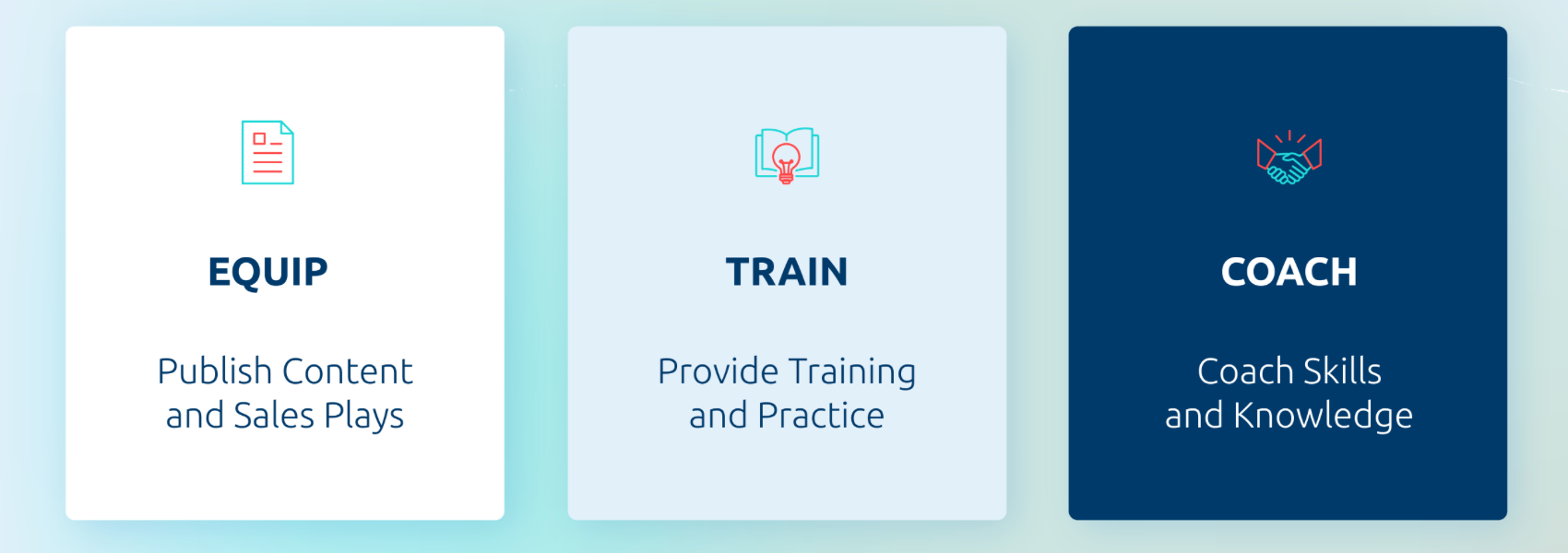
Now that you know what you want the sales team to do, it's time to execute. We divide execution into three pillars: Equip, Train, and Coach. Let's look at each of them.
Equip sellers with the resources they need
The first part of execution is making sure that you equip your sellers with the content and guidance they need to be successful.
You are successfully equipping your sellers if they can say, "I get it. I know what you want me to do, and I have the tools to execute on it."
Content That Supports Your Go-to-Market
Sellers need to be equipped with the right content to be successful with customers:
- Externally facing collateral, such as pitch decks, white papers, and case studies. These carry your message directly to the customer and help contacts act as mobilizers within the organization. Ideally you support each sales conversation along the buyer's journey with compelling content that reps can use and share. Presentations help model how those conversations should be structured.
- Internally facing content, such as demo scripts, answers to objections, and price sheets. They provide key information that sellers need to have at their fingertips to be successful.
It takes a lot of effort to build great content ...but it doesn't provide any value unless sellers are using it.
In too many organizations, most "customer-facing content" is rarely or ever seen by a customer. This is evident in the fact that Forrester found that 70% of marketing content goes unused by sales.
To get the maximum value from the content, ensure you provide the following:
- The company needs a trusted system that acts as a single point of truth.
- Sellers should have a compelling experience where they can quickly find what they need.
- Content managers need a system that makes it easy to govern and archive content over time.
- Content creators need data to know what is being used and what works.
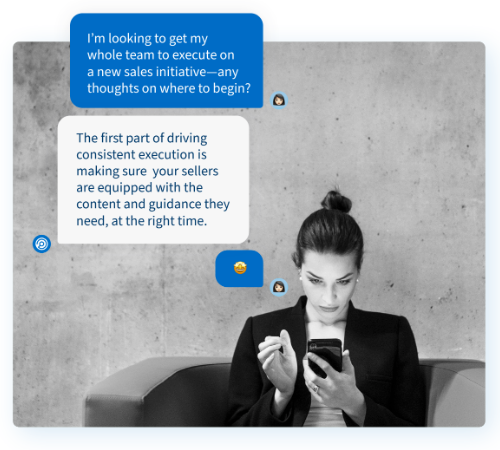
Frequently, content producers, such as marketing, have limited information about how the materials they produce are being used in practice by sales or how they are being consumed by customers.
Companies also often lack standard processes that get sellers and marketers in the same room to align on what's really needed.
Content governance is either too tightly managed, to the point that most "real" content bypasses the process, or virtually nonexistent, forcing sellers to wade through content that is useless or out of date.
The triple threat of too much content, poor governance, and a weak platform to organize and find the content means that reps finding what they need is a nearly impossible task for too many sellers.
They download whatever they can find that seems useful and assemble their own sales kit (often sticking to it even after it is way out of date).
Guidance via Sales Plays that show what "good" looks like
If we want to get sellers to do something that is new or different, we need to be specific about exactly what it is we want them to do. Sales plays are the answer to this challenge. They pull together what a seller needs to know, say, show, and do in a particular situation, and they present it in a consistent format that is easy to use.
The modern sales play bears little resemblance to the sales playbooks of old.
Remember the three-ring binders that were printed at great expense and handed out at training sessions, only to gather dust on a shelf? Or the 80-page PDF that might still lurk in a corner of your sales portal? While those tomes were often very comprehensive, they had many challenges:
- They were overwhelming and hard to navigate.
- They were extremely expensive to evolve, so they quickly went out of date.
- They described the theory of how deals were supposed to happen, but often the reality was very different and the recommendations weren't useful for sellers trying to get something done
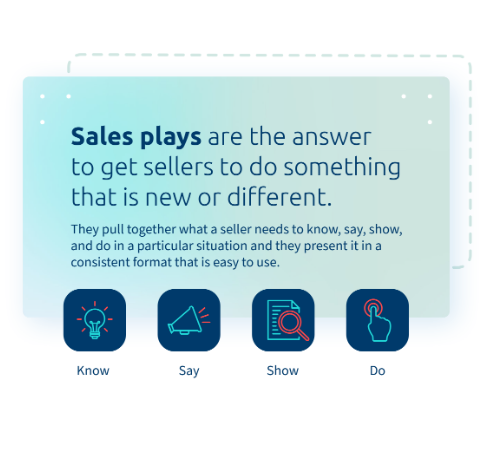
By contrast, the modern sales play serves as a "quick reference guide" that makes it easy for the seller to find what they need and take action. Modern sales plays do the following:
- Are built to serve the seller, with clear calls to action.
- Live where the seller works-often directly in the CRM system.
- Are easy to find and navigate, being built in digestible, bite-sized elements.
- Include the specific assets and tools sellers need to do their jobs.
- Provide real examples-via recorded calls or videos-of top performers doing whatever it is that the seller needs to do.
Each seller shouldn't have to reinvent the wheel regarding what a good conversation sounds like. Without the guidance that sales plays provide, you are asking every seller to do a lot of guesswork and figure it out for themselves.
Train your teams to build confidence
If you've done your job during the Equip phase, you have written down "what good looks like." But that doesn't mean sellers are actually able to do it. Buying a great book on skiing isn't going to get you down a slope.
Training is how sellers build new skills and master new material.
Just as important, it's also how they build confidence in themselves. Most sellers are reluctant to try something new with a customer, unless they are sure they can nail it.
You know you are getting this right if sellers can say, "I am confident that I have the skills to execute on this initiative," - and if their managers can be confident that they are right.
Many companies short-change training in three ways:
1. They use an outdated training approach ("death by PowerPoint")
- Training is passive and boring, limiting engagement.
- Too much material is presented at a time, limiting what sellers can absorb.
- Training isn't personalized and doesn't let sellers move at their own pace, causing some to be bored and others overwhelmed.
2. Limited opportunities for sellers to practice
There are limited opportunities for sellers to practice, so they don't build the confidence needed to apply new skills in the real world.
3. Training isn't reinforced
Training isn't reinforced by frontline managers in their regular coaching activities, so the half-learned skills are quickly forgotten.
There is a lot of great research on how people master new activities, and the evidence is overwhelming that passive learning isn't very effective.
The stereotypical sales training has sellers sitting glumly through a seemingly endless set of slides and lectures, trying to stay awake. It may be a cliché, but it's still happening, and it's a poor way to absorb material and be ready to put it into practice.
Coach your teams to mastery
The final piece of the puzzle is making sure that sellers are actually doing the new activities effectively in the real world, which depends on managers to actively coach them.
This is probably the biggest gap at most companies we've worked with, and it is where many strategic initiatives die.
Sellers are very, very busy, and they usually live in a constantly changing and stressful environment. At most organizations, most of them are not attaining quota (a typical company, for example, has only about 30% of their sellers hitting full quota).
Under huge pressure to drive their numbers, sellers are reluctant to adopt new initiatives when they are already struggling to master all the things they're already being asked to do.
The most likely (and most natural) response to the latest new thing that comes along? Ignore it.
To drive change, you have to push through that resistance. It is essential to enlist the support of your frontline managers, because they are the ones in direct and constant contact with sellers. Managers need to help sellers refine their craft, develop mastery, and hold them accountable for performing the new activity.
That is easy to say, but few companies get it right. Coaching often happens in pockets, driven by a select few managers who are particularly skillful and tenacious.
The companies that are successful at scaling effective coaching across their management teams tend to do the following:
- Have senior leaders who model effective coaching and visibly reinforce its importance.
- Create accountability for frontline managers to be effective coaches by measuring coaching effectiveness.
- Standardize on a common coaching methodology.
- Define what good coaching looks like for specific, high-impact situations
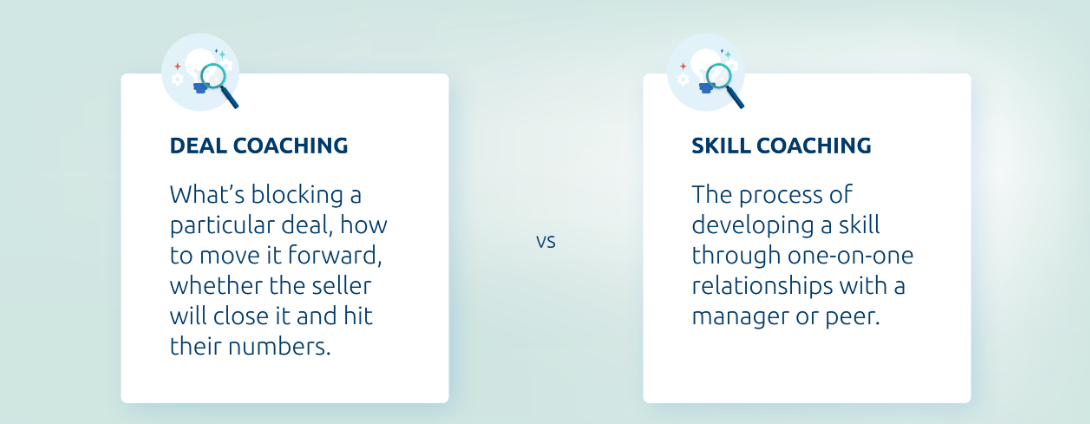
To create an effective culture of coaching, companies also need to clearly distinguish between deal vs. skill coaching.
Most sales managers were promoted because they were good at sales, so they are very comfortable working a deal.
They naturally fall into deal coaching when they talk to their people-what's blocking a particular deal, how to move it forward, whether the seller will close it and hit their numbers, and so on.
To use a sports analogy, if a coach calls a timeout during a game to sync up with the players on the field before a big play, that's deal coaching.
But if a coach plays back a video clip after the game, shows the player what went wrong, and then takes them out to practice and runs them through that same situation many times with other players and gives them feedback, that's skill coaching.
Both are important opportunities for managers to help their sellers be successful.
However, deal coaching alone will only get you so far. Y ou only have so many timeouts to call. In the moment, you might help save a game, but it is primarily through skills coaching that you create a better player. It is through skills coaching that change happens.
To support skills coaching, give your managers a framework defining the skills they should coach and guidance on how to coach them effectively. Your goal is for sellers to say, "I have the support I need to be successful at this new activity with customers."
You know coaching is working if the following conditions are true:
- You can track which sellers are executing the new behavior with customers.
- Managers understand their role in coaching the new behavior, and change their own behaviors as needed to be more effective coaches.
- Your operational cadence drives accountability for both sellers and managers.
Analyze activity
Historically, one of the biggest challenges with enablement was that companies didn't have the data to know what's actually happening on the field.
Content, for example, was traditionally produced by marketing and thrown over the wall to sales. Marketers could get very little insight into what was really getting used and what was having an impact on customers to drive business.
They were forced to rely on anecdotes and guesswork to assess impact and guide future investments.
Today, the situation is radically different.
As has happened in virtually every other aspect of business, there has been a transformation in the breadth and depth of data available. Modern tools give you powerful ways to track, assess, and hone your efforts.
As you think about how to analyze your strategic initiatives and foundational
programs, it is important to distinguish between activities and outcomes.
Activities can be directly managed, and the sales team is in control of whether they happen or not. Outcomes are influenced by activities, but cannot be directly managed - they emerge from doing the activities effectively.
As a simple example, the number of emails sent per day is an activity, while the percentage of people who open the email is an outcome. Activity metrics are a good place to start in assessing whether your enablement investments are getting traction, because they are leading indicators.
Success starts from having the right activity happening in the field.
There are two primary types of activity metrics you will want to look at:
Internal activity
Find out whether sellers are engaging with your initiative
and leveraging the work you did to Equip, Train, and Coach them.
Are they reading the sales plays, reviewing the content, and taking and completing the training? If they aren't paying attention, you are going to have a hard time driving change.
If you are getting poor engagement, perhaps you haven't convinced them of the value.
Reps are usually busy and stretched thin; you have to sell the seller by giving them a compelling reason to pay attention to something new.
Or, perhaps the material isn't compelling. The sales play isn't approachable, bite-sized, and actionable. The training is long, boring, and doesn't feel relevant. Look at your drop-off rate as an indicator.
External activity
Check whether sellers are engaging in the right activities in the
field. That is what sales teams can truly control - what sellers do.
For example, if you want sales to engage every existing customer
on a cross-sell motion, is that happening? Activity metrics generally come from a variety of different systems, including (but not necessarily limited to) your CRM and enablement platforms. The key question to ask is, "What activities do sellers need to be doing in order to be successful?" Track those.
If you aren't getting the activity you want, consider whether you have a mindset problem (sellers don't believe in what you are asking them to do), a skill problem (they aren't confident they can do it successfully), or an accountability problem (they haven't prioritized it and aren't being held to it by managers).
These views allow you to assess how well your initiative is landing in the field -whether sellers are engaging with them and then doing the actions needed
to make them successful.
Business outcomes
Ultimately, the goal of enablement is to help companies achieve business outcomes
by driving change in their organizations.
That means it is critical for business leaders to align internally on what those goals are and to make sure that enablement activities are driving toward those goals.
This may sound obvious, but on a daily basis we run into enablement practitioners who have been asked to execute on a program with little context as to how that program will impact the business. We also see many situations where marketing, sales, and enablement have different and independent goals, so the teams aren't acting together from a common purpose.
At the highest level, there are generally a set of company outcomes that the C-Suite and the board use to measure the company's success.
Financial: Accounting measures of revenue, profitability, or cost (including financial forecasts).
Stakeholder satisfaction: Perception of your company by customers and employees.
Market share: Portion of your target market that you have captured.
While these goals are critically important to the business, they are often too high-level and abstract for enablement teams to drive directly.
We find that it is generally better to focus on sales, marketing, and enablement outcomes that are more directly tied to specific investments and
initiatives.
Business outcomes generally fall into two main categories:
Sales outcomes
While revenue is obviously a common measure of success, there are a range of other metrics that sales also cares about, for example, seller ramp time and retention.
These metrics also include indicators that are critical for understanding the health of the business, like the seller participation rate (how many reps are hitting quota), pipeline generation (a key indicator about the future of the business), win rate (measuring competitiveness and ability to drive urgency), and the like.
In addition to such standard metrics that are used across many businesses, sales might also be driving toward outcomes that are specific and critical to their business.
Marketing outcomes
Marketing teams have many outcomes that they focus on, some of which are driven directly and others that rely on the field to be successful.
For example, generating brand awareness through marketing campaigns is often managed directly.
But other outcomes are heavily dependent on "landing in the field," such as generating revenue through new strategic initiatives (e.g., launching a new product) and content ROI (influencing revenue through content shared with customers by the field).
By defining the outcome you are driving toward, the more specific you can be, and the more likely you are to measure the effectiveness of your efforts.
For example, "grow top-line revenue by 10%" is not usually specific enough to connect with any one particular initiative. There are many ways to grow revenue. A better outcome metric is directly tied to the change you are trying to drive.
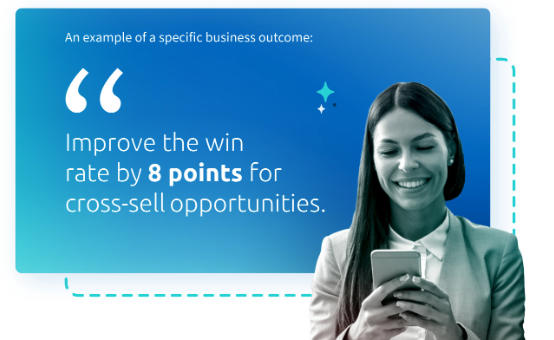
Another practice to consider is to identify a set of outcomes that lead from the specific activity you are driving to the ultimate business impact you want to have.
In the previous example, you might look at the number of new cross-sell opportunities at each stage of the funnel, leading finally to the win rate.
This approach gives you early indications of success-you don't have to wait until deals close to see whether you are getting traction-and can help diagnose where problems lie, if you aren't getting the results you want.
By clearly identifying the outcome you are driving and how you will measure it, each function understands why the change is necessary and how to know if it happened successfully. It is also an important way to test your call to action.
- If the field successfully makes the change you are driving, is that enough to achieve the goal?
- What positive impact on the business will the change have? If you aren't sure what metric you will look at to measure improvement, you may need to rethink whether you have chosen the right call to action.
For the teams that are investing in enablement, you can combine the activity metrics and the business outcome data to measure:
It is costly to create content, plays, and training. Is it delivering the business impact you need? Measure internal engagement (whether the intended audience used the content, viewed the play, completed the training).
For customer-facing assets, measure external engagement and impact-whether it was used with customers, whether it engaged them, and how much revenue it influenced. We routinely see that different types of content generate 10x or even 100x the amount of internal usage and external engagement.
Use that data to measure ROl and guide future investments.
Enablement platform
In order to do strategic enablement, you need to have the capability in place to implement this framework. That means you need the right team, tools, and processes.
Team
Enablement teams often organize themselves in two ways:
- Activity-specific: Cross-cutting activities, such as managing content, often have dedicated headcount.
- Audience-specific: Many teams dedicate headcount to the major audiences they are serving, for example, account executives and account managers.
There are a mix of backgrounds that can provide very helpful context for enablement. We most commonly see people coming from sales, product marketing, learning and development, and operations.
Tools
- Sales Enablement Platform: An integrated solution for providing content, guidance, training, and coaching to the sales team.
- Analytics Dashboards: Provides views on the activity and performance of sellers, content, plays, and training. The CRM and enablement platforms provide many of these insights, but companies often draw additional metrics from other systems.
Processes
- Content Governance: A cross-functional model for ensuring that the content available to sales is fresh, accurate, effective, and used.
- Enablement Methodology: A systematic way to drive change into the field and achieve consistent execution.
Enablement teams typically run a series of ongoing programs and events that
they use to engage the field.
Sales onboarding: The program every new rep goes through to get them ready to sell
Sales training: Ongoing training sessions to develop skills and knowledge
Assessments and certifications: Program for reps to prove their skill and be recognized
Sales communication: Forums and channels for leadership to stay in touch with the field
Sales Kickoff (SKO): Annual event to educate sellers about new priorities and initiatives
Many companies are still in the process of putting these foundational programs into place and refining them. That is essential for getting the sales team ready to sell effectively ... but it isn't enough.
That is a trap we often see enablement teams fall into once the basics are solid. They have an onboarding program, they've built sales communication channels, and they deployed a sales enablement solution.
It's a great start, and the business is much better off ... but the enablement teams hit a plateau and struggle to show how they can go beyond running programs to become a strategic lever for the business.
The answer? Develop the ability to prioritize specific business outcomes, identify the right calls to action, and systematically drive execution that yields results.
For most companies, the market is constantly changing, the product is evolving, new ways of selling are being developed, the competitors are swarming your weak spots, and you have to rapidly evolve.
Your sellers need to be learning machines to keep winning deals in rapidly changing conditions, and companies need to help them achieve that. So make sure your foundations are strong, and then use them to intentionally drive change and achieve the most important priorities of the business.
The framework in action
Putting it all together, here are the steps for applying the framework to your business:
1. Identify the business outcomes that you are trying to achieve
Business leadership needs to decide on the key priorities for this period (quarter, year, etc.) and how success will be measured.
Often it is useful to identify granular sales outcomes (e.g. conversion rate from the Discovery stage to the Prove Value sales stage) as well as the ultimate goals that the business is trying to achieve (e.g. cross-sell revenue for a new product line).
2. Define the call to action
Given the outcomes you are aiming for, ask, "What is it going to take?".
Clearly determine exactly which activities are supposed to be done by which set of people under which circumstances. Pick the most important activity to start with, and then work down your list.
It's hard to focus down to a small number, but the field can only absorb change at a certain pace, and building excellence takes time. Trying to do too many things means that none of them will truly land.
3. Equip sellers with content and guidance
Provide the internal- and external-facing content they need, together with sales plays that define what sellers need to know, say, show, and do in the key selling situations.
4. Train sellers with courses, practice sessions, and certifications
Give sellers training that includes opportunities to practice and build confidence. If appropriate, have them prove their skills through certifications.
5. Show managers how to coach the sellers on the activity
Foster skills coaching in addition to deal coaching by prioritizing what managers should be coaching on and providing frameworks and resources for how to do it.
Consider creating coaching plays that walk managers through it.
6. Launch the initiative through your enablement platform (starting with managers)
Leverage the foundations that your enablement team has put into place in order to get the initiative in front of the field.
Share the priorities and success stories with the field through your sales communication channels and your events.
Put the content, guidance, and training in your enablement solution, targeted at the appropriate sales roles, and include it in your ongoing sales development program.
7. Analyze and drive activity, outcome, and impact
Use analytics to measure and drive how your initiative is landing in the field.
Assess enablement activity to see if sellers are engaging. Look at sales activity to see if the change you are trying to drive is happening. Look at sales and business outcomes to see if you are getting the results you want.
Measure the enablement impact to drive ROl on your content, guidance, training, and coaching investments.
Conclusion
We are living in a time of rapid and constant change, and companies need to be able to adapt even faster.
They can't just react. They need to be able to find and seize strategic opportunities that let them grow and thrive.
They need sales agility - a way to reliably turn new ideas into systematic and disciplined execution in the field. That urgent need is why enablement is evolving so rapidly. From a disconnected set of programs, it has turned into a discipline, with a well-defined and rigorous methodology for driving success at scale and powerful tools to support it.
It's a pretty new idea ... and it's an idea that's spreading like wildfire, because companies are seeing huge benefits as they invest in it. Just getting the foundations in place is a great start, and that's the focus for many companies that are early in their enablement journey.
But when you move from there to strategic enablement, creating an effective and repeatable model for executing on your top business priorities, that's when you really begin to unlock the potential of your sales teams to sell-and for your business to grow.
We've watched as our customers have used this approach to grow dramatically.
They've used it to enter the public markets and deliver quarter after quarter. They've weathered the dramatic changes of a global pandemic and created an effective and repeatable model to evolve their businesses. They've taken control, defining their strategy and pursuing it with determined focus and disciplined execution.
We believe that strategic enablement is a powerful lever for driving change and growing your business. We hope that the Strategic Enablement Framework helps you put your organization on the enablement path to success.
Highspot delivers the industry's best sales enablement platform and tools for increasing marketing effectiveness, sales efficiency, and revenue.


Sales enablement insider
Thank you for subscribing
Level up your sales enablement career & network with sales enablement experts
An email has been successfully sent to confirm your subscription.
 Follow us on LinkedIn
Follow us on LinkedIn


.png)
